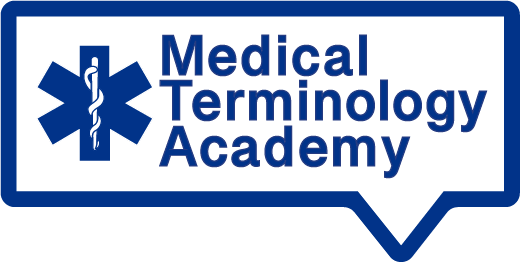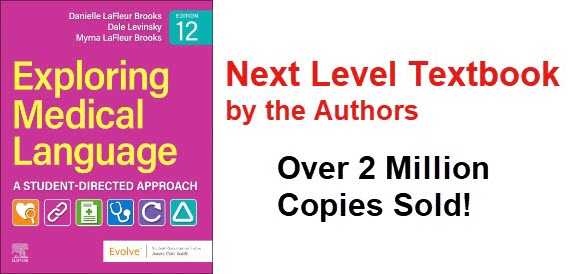Basic Medical Terminology Self-Study Guide Syllabus
Completion Time: It is estimated that it will take 32 hours to complete the self-study program. The self-study guide and textbook program is self-paced and can be completed according to the student’s own schedule.
Required Text: Basic Medical Language, Seventh Edition LaFleur Brooks, Levinsky, and LaFleur Brooks, Elsevier
Faculty Support: Myrna LaFleur Brooks and Danielle LaFleur Brooks
Description
Word parts, medical terms, and abbreviations are introduced by body systems. Diseases and disorders, signs and symptoms, medical procedures and therapeutics, and medical specialties are included. The self-study guide and textbook stress the proper pronunciation, spelling, and usage of medical terms.
Learning Objectives
1. Describe the origin of medical terms.
2. Define the four word parts and the combining vowel.
3. Identify the major body system structures and their related word parts.
4. Build, translate, pronounce, and spell medical terms built from word parts.
5. Describe organizational components of the body, directional terms, anatomic planes, regions, and quadrants.
6. Define medical terms related to diseases and disorders, signs and symptoms, medical procedures and therapeutics, and medical specialties.
7. Identify plural endings for medical terms.
8. Define medical terms used in oncology.
9. Recognize common abbreviations used in each body system and specialty area.
Outline
Topic
Material Needed
Assignment
Lesson 1: Introduction to Medical Language, Body Structure, Oncology, and Laboratory Tests, p. 1
Textbook Lesson 1
Complete Lesson 1 textbook exercises and online activities
Take the end of Lesson 1 quiz
Lesson 2: Directional Terms, Positions, and Imaging, p. 32
Textbook Lesson 2
Lesson 2 Online Practice Student Resources
Complete textbook Lesson 2 exercises and online activities
Take the end of Lesson 2 quiz
Lesson 3: Integumentary System, Colors, and Plural Endings, p. 59
Textbook Lesson 3
Lesson 3 Online Practice Student Resources
Complete Lesson 3 textbook exercises and online activities
Take the end of Lesson 3 test
Lesson 4: Respiratory System, p. 88
Textbook Lesson 4
Lesson 4 Online Practice Student Resources
Complete Lesson 4 textbook exercises and online activities
Take the end of Lesson 4 quiz
Lesson 5: Urinary System, p. 126
Textbook Lesson 5
Lesson 5 Online Practice Student Resources
Complete Lesson 5 textbook exercises and online activities
Take the end of Lesson 5 quiz
Lesson 6: Reproductive Systems, p. 159
Textbook Lesson 6
Lesson 6 Online Practice Student Resources
Complete Lesson 6 textbook exercises and online activities
Take the end of Lesson 6 quiz
Lesson 7: Cardiovascular and Lymphatic Systems, p. 195
Textbook Lesson 7
Lesson 7 Online Practice Student Resources
Complete Lesson 7 textbook exercises and online activities
Take the end of Lesson 7 quiz
Lesson 8: Digestive System, p. 231
Textbook Lesson 8
Lesson 8 Online Practice Student Resources
Complete Lesson 8 textbook exercises and online activities
Take the end of Lesson 8 quiz
Lesson 9: Eye and Ear, p. 271
Textbook Lesson 9
Lesson 9 Online Practice Student Resources
Complete Lesson 9 textbook exercises and online activities
Take the end of Lesson 9 quiz
Lesson 10: Musculoskeletal System, p. 301
Textbook Lesson 10
Lesson 10 Online Practice Student Resources
Complete Lesson 10 textbook exercises and online activities
Take the end of Lesson 10 quiz
Lesson 11: Nervous System and Behavioral Health, p. 343
Textbook Lesson 11
Lesson 11 Online Practice Student Resources
Complete Lesson 11 textbook exercises and online activities
Take the end of Lesson 11 quiz
Lesson 12: Endocrine System, p. 376
Textbook Lesson 12
Lesson 12 Online Practice Student Resources
Complete Lesson 12 textbook exercises and online activities
Take the end of Lesson 12 quiz

